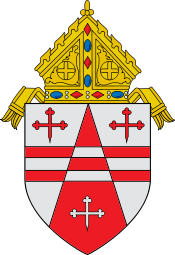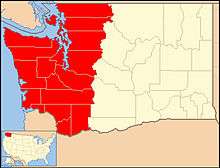Roman Catholic Archdiocese of Seattle
| Archdiocese of Seattle Archidioecesis Seattlensis | |
|---|---|
 | |
| Location | |
| Country | United States |
| Territory | Western Washington |
| Ecclesiastical province | Archdiocese of Seattle |
| Statistics | |
| Area | 64,269 km2 (24,814 sq mi) |
| Population - Total - Catholics |
(as of 2016) 5,501,540 863,000 (15.7%) |
| Parishes | 144 |
| Churches | 183 |
| Schools | 75 |
| Members | 972,000 |
| Information | |
| Denomination | Roman Catholic |
| Rite | Roman Rite |
| Established |
May 31, 1850 (as Diocese of Nesqually) Elevated to Archdiocese June 23, 1951 |
| Cathedral | St. James Cathedral |
| Patron saint | St. James the Greater[1] |
| Secular priests | 115 |
| Current leadership | |
| Pope | Francis |
| Archbishop | J. Peter Sartain |
| Auxiliary Bishops |
Eusebio L. Elizondo Almaguer Daniel Henry Mueggenborg |
| Emeritus Bishops |
Raymond Hunthausen Alexander Joseph Brunett |
| Map | |
 | |
| Website | |
| seattlearchdiocese.org | |
The Roman Catholic Archdiocese of Seattle is a Latin Metropolitan archdiocese of the Catholic Church, in the U.S. state of Washington. Headquartered in Seattle, the archdiocese encompasses all counties in the state west of the Cascade Range.
Its present archbishop is J. Peter Sartain.
Its cathedral of the archiepiscopal see is St. James Cathedral in Seattle, and the former cathedral is the Proto-cathedral of St. James the Greater, in Vancouver, Washington.
The archdiocese succeeded to the Diocese of Nesqually headquartered in Vancouver, Washington, established in 1850 as a suffragan diocese of the Archdiocese of Oregon City. In 1903, the episcopal see was moved to Seattle, and the diocese's name was changed to Diocese of Seattle in 1907. The diocese was elevated to Metropolitan archdiocesan status in 1951.
Ecclesiastical province
The Archbishop of Seattle concurrently is the Metropolitan Archbishop of two suffragan daughter dioceses within the Ecclesiastical Province of Seattle, which together cover the entire state of Washington :
- Roman Catholic Diocese of Spokane, carved out of the Archdiocese of Seattle territory in 1913
- Roman Catholic Diocese of Yakima, carved out of the Archdiocese of Seattle territory in 1951.
Statistics and extent
As per 2014 it pastorally served 997,000 Catholics (18.6% of 5,350,045 total) on 64,269 km² in 147 parishes with 298 priests (204 diocesan, 94 religious), 116 deacons, 476 lay religious (109 brothers, 367 sisters) and 30 seminarians.
The Archdiocese encompasses all of Western Washington, 64,269 km², stretching from the Canadian to the Oregon border and from the Cascade Mountains to the Pacific Ocean, including 19 counties.
In this area, 972,000 people identify as Catholic, almost 19% of the total population of 5,202,500.[2]
There are 144 parishes, and an additional 37 missions, stations, and pastoral centers. Only 106 of these have resident priest-pastors.
These parishes and other centers are served by 115 active diocesan priests, 118 diocesan deacons, approximately 800 diocesan lay ecclesial ministers, and 530 religious women and men (including priests). The archbishop is assisted by one auxiliary bishop, and there are two retired archbishops still living. There is also a Benedictine abbey with its own abbot.
There are 11 Catholic Hospitals, 2 Health Care Centers, 19 Homes for the elderly, 3 day care centers, 10 specialized homes, and 111 centers for social services.
There are 2 Catholic universities, 11 high schools, 62 elementary schools.
16,831 elementary students are served through parochial and private schools; 29,850 through parochial religious education programs.
2420 high school students are served through diocesan and private schools; 6580 through parochial religious education and youth ministry programs. [3]
History
Antecedents
The Catholic Church presence in the present-day state of Washington dates to the 1830s, when missionary priests François Norbert Blanchet and Modeste Demers traveled from Quebec and arrived in what was then known as the Oregon Country. On December 1, 1843, the Holy See established the Vicariate Apostolic of the Oregon Territory and named Blanchet its vicar apostolic. In 1846 Pope Gregory XVI established an ecclesiastical territory in the region, and the apostolic vicariate was split into three dioceses: Diocese of Oregon City with François Blanchet as bishop; Diocese of Vancouver Island, with Demers as bishop, and Diocese of Walla Walla at Walla Walla, Washington, with François Blanchet's brother, Augustin-Magloire Blanchet, as bishop.
The Whitman massacre in 1847 and the ensuing Cayuse War increased tensions between Christians and the native population of the Oregon Territory, and as a result by 1850 the Diocese of Walla Walla was abandoned and its merged-in territory administered from Oregon City.
On May 31, 1850, Pope Pius IX created the Diocese of Nesqually out of the defunct Walla Walla diocese, with Augustin Blanchet as bishop. In January 1851, Augustin Blanchet dedicated St. James Church near Fort Vancouver as the new diocese's cathedral. A new St. James Cathedral was built in Vancouver, Washington in 1885.
(Arch)diocesan history
In 1903 Bishop Edward O'Dea, realizing that Vancouver was no longer the economic and population center of the region, moved the episcopal see to Seattle and began construction on a new cathedral in 1905. The bishopric changed its name to Diocese of Seattle on September 11, 1907, and the present-day St. James Cathedral was dedicated on December 22, 1907.
On 1913.12.17 it lost territory to establish the Diocese of Spokane, now its oldest suffragan.
It was elevated on June 23, 1951 as Metropolitan Archdiocese of Seattle and Bishop Thomas Arthur Connolly became the first archbishop.[4] Simultaneously it lost territory to establish the Diocese of Yakima, its second suffragan.
In 1983, Cardinal Joseph Ratzinger, the Prefect of the Congregation for the Doctrine of the Faith (CDF), initiated an apostolic visitation to the Archdiocese of Seattle. The visitation was largely prompted by concerns over whether the archdiocese under Archbishop Raymond Hunthausen was adhering to church teachings on matters including contraception in Catholic hospitals, and its treatment of homosexuals and divorced people.[5] Archbishop James Hickey of the Archdiocese of Washington, DC was sent to Seattle to gather information on behalf of the CDF.[6] As a result of the CDF's findings, on December 3, 1985, the Vatican under Pope John Paul II named Donald Wuerl auxiliary bishop of Seattle, with the authority to overrule Hunthausen in several areas. This unconventional arrangement proved untenable and unpopular among the people of the archdiocese, and Wuerl was replaced with Thomas Murphy on May 26, 1987. Murphy was appointed as coadjutor bishop with immediate right of succession to Hunthausen; he became archbishop upon Hunthausen's retirement on August 21, 1991.
Under Archbishop Murphy the archdiocese saw an increase in registered Catholics and an increase in lay ministries and outreach for women and various ethnic groups. He was diagnosed with acute myeloid leukemia in December 1996, and died on June 26, 1997. Father George Leo Thomas was appointed administrator of the archdiocese until the installation of Archbishop Alexander Joseph Brunett in December 1997. Brunett later appointed and consecrated George Thomas as auxiliary bishop, a post he held until his appointment as Bishop of Helena in 2004. Eusebio L. Elizondo Almaguer and Joseph J. Tyson were appointed as auxiliary bishops and consecrated in 2005; Elizondo still serves in that capacity, while Tyson departed in 2011 to become Bishop of suffragan see Yakima. Brunett served as archbishop until his retirement in 2011 and was succeeded by the incumbent bishop, J. Peter Sartain.
Episcopal Ordinaries and Auxiliary bishops
(all Roman Rite)
[PRECURSOR SEE :
- Suffragan Bishops of Nesqually
- Augustin-Magloire Blanchet (1850–1879)
- Egidius Junger (1879–1895)
- Edward John O'Dea (June 13, 1896 – September 11, 1907 see below) ]
- Suffragan Bishops of Seattle
- Edward John O'Dea (see above September 11, 1907 – December 25, 1932; died)
- Gerald Shaughnessy, Society of Mary (Marists, S.M.) (July 1, 1933 – May 18, 1950; died)
- Thomas Arthur Connolly (May 18, 1950 – June 23, 1951 see below); previously Titular Bishop of Sila (June 10, 1939 – May 18, 1950); first as Auxiliary Bishop of San Francisco (June 10, 1939 – February 28, 1948), then as Coadjutor Bishop of Seattle (February 28, 1948 – succession May 18, 1950).
- Metropolitan Archbishops of Seattle
- Thomas Arthur Connolly (see above June 23, 1951 – February 13, 1975; retired)
- Auxiliary bishop Thomas Edward Gill (April 11, 1956 – November 11, 1973; died), Titular Bishop of Lambæsis (April 11, 1956 – November 11, 1973)
- Raymond Hunthausen (February 25, 1975 – August 21, 1991; retired); previously Bishop of Helena (July 8, 1962 – February 25, 1975)
- Auxiliary bishop Nicolas Eugene Walsh (August 10, 1976 – September 6, 1983; retired), Titular Bishop of Bolsena (August 10, 1976 – September 6, 1983); previously Bishop of Yakima (September 5, 1974 – August 10, 1976)
- Auxiliary bishop Donald Wuerl (November 30, 1985 – May 26, 1987), Titular Bishop of Rosemarkie (November 30, 1985 – February 11, 1988); Bishop of Pittsburgh (February 11, 1988 – May 16, 2006); Metropolitan Archbishop of Washington, D.C. (May 16, 2006 – ...); created Cardinal-Priest of S. Pietro in Vincoli (November 20, 2010 – ...)
- Thomas Joseph Murphy (August 21, 1991 – June 26, 1997; died); previously last Bishop of Great Falls (July 5, 1978 – February 14, 1980), restyled first Bishop of Great Falls–Billings (February 14, 1980 – May 26, 1987)
- Alexander Joseph Brunett (October 28, 1997 – September 16, 2010; retired); previously Bishop of Helena (April 19, 1994 – October 28, 1997); later Apostolic Administrator of Oakland (October 4, 2012 – May 3, 2013)
- Auxiliary bishop George Leo Thomas (November 19, 1999 – March 23, 2004), Titular Bishop of Vagrauta (November 19, 1999 – March 23, 2004); next Bishop of Helena (March 23, 2004 – ...)
- Auxiliary bishop Joseph J. Tyson (May 12, 2005 – April 12, 2011), Titular Bishop of Migirpa (November 19, 1999 – March 23, 2004); next Bishop of Yakima (April 12, 2011 – ...)
- J. Peter Sartain (September 16, 2010 – ...); previously Bishop of Little Rock (January 4, 2000 – May 16, 2006), Bishop of Joliet (May 16, 2006 – September 16, 2010).
Present Auxiliary bishops of Seattle
- Auxiliary bishop Eusebio Elizondo Almaguer, Missionaries of the Holy Spirit M.Sp.S. (May 12, 2005 – ... ), Titular Bishop of Acholla (May 12, 2005 – ... )
- Auxiliary bishop Daniel Henry Mueggenborg (6 April 2017 – ...), Titular Bishop of Tullia, Numidia (6 April 2017 – ...), no previous prelature
Catholic High schools
- Archbishop Murphy High School* - Everett
- Bellarmine Preparatory School* - Tacoma
- Bishop Blanchet High School - Seattle
- Eastside Catholic School* - Sammamish
- Forest Ridge School of the Sacred Heart* - Bellevue
- Holy Names Academy* - Seattle
- John F. Kennedy Catholic High School - Burien
- O'Dea High School - Seattle
- Pope John Paul II High School* - Lacey
- Seattle Preparatory School* - Seattle
- St. Elizabeth Ann Seton Catholic High School* - Vancouver
- * Operationally independent of Archdiocese
See also
- Catholic Church in the United States
- Global organisation of the Catholic Church
- List of Catholic dioceses (alphabetical) (including archdioceses)
- List of Catholic dioceses (structured view) (including archdioceses)
- List of Catholic dioceses in the United States
References
- ↑ Paulist Press Ordo 2010
- ↑ "The Archdiocese". Archdiocese of Seattle.
- ↑ "Table of Statistics" (PDF). Archdiocese of Seattle.
- ↑ "Local Catholic History". Archives and Records, Catholic Archdiocese of Seattle. Retrieved 2010-06-17.
- ↑ "Raymond Hunthausen". People. 1986-12-22.
- ↑ Seattle Catholic Journal: Joseph Cardinal Ratzinger's Report Issued on Seattle Archbishop Raymond Hunthausen, September 30, 1985
Sources and external links
- Roman Catholic Archdiocese of Seattle Official Site
- GCatholic - Seattle see, with Google map and satellite photo - data for most sections
- St. James Cathedral
Coordinates: 47°36′23″N 122°19′32″W / 47.60639°N 122.32556°W
